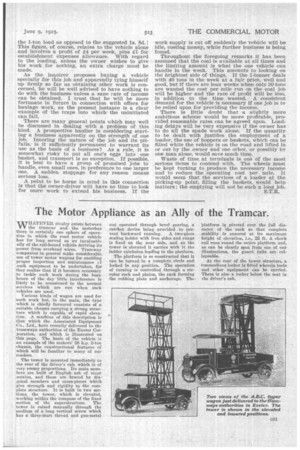The Motor Appliance as an Ally of the Tramcar.
Page 15

If you've noticed an error in this article please click here to report it so we can fix it.
WHATEVER rivalry exists between the tramcar and the motorbus there is certainly one sphere of operation in which the road motor vehicle has for long served as an invaluable ally of the rail-bound vehicle deriving its power from overhead wires. Tramway companies in general make considerable use of tower motor wagons for enabling proper inspection and maintenance cf such equipment to be undertaken, for they realize that if it becomes necessary to tackle such work during the busy hours of the day little interference is likely to be occasioned to the normal services which are run when suck vehicles are used.
Various kinds of wagon are used for such work but, in the main, the type which is chiefly favoured consists of a suitable chassis carrying a strong structure which is capable of rapid elevation. A machine of this description is that which the Associated Equipment Co., Ltd., have recently delivered to the tramways authorities of the Exeter Corporation, and which is illustrated on this page. The basis of the vehicle is an example of the makers' 28 h.p. 2-ton chassis, the constructional features of which will be familiar to many of our readers.
The tower is mounted immediately to the rear of the driver's cab, which is of very roomy proportions. Its main members are built of English ash of stout section, and these are braced by diagonal members and cross-pieces which give strength and rigidity to the complete structure. It is built in two sections, the tower, which is elevated, working within the compass of the fixed section of the superstructure. The 'tower is raised manually through the medium of a long vertical screw which has a three-start thread and gun-metal nut operated through bevel gearing, a ratchet device being -provided to prevent backward running. A two-piece scaling ladder with iron sides and rungs is fixed on the near side, and as the tower is elevated it carries with it the ladder extension leading to the platform.
The platform is so constructed that it can be turned in a complete circle and locked in any position. The operation of turning is controlled through a circular rack and pinion, the rack forming the rubbing plate and anchorage. The Platform iq pivoted over the full diameter of the rack so that complete stability is ensured at its maximum height of elevation, i.e., 22 ft. A chock rail runs round the entire platform and, as can be clearly seen from one of our illustrations, the guard rails are collapsable.
At the rear of the tower, structure a Commodious locker is fitted wherein tools and other equipment can be carried. There is also a locker below the scat in the driver's cab.






























